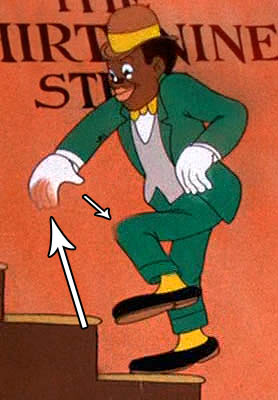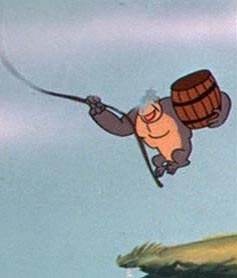May 24, 2005
Digital Noise Reduction
is not always your friend. Especially automated systems (ie: cheap). Some people who are fans of the old cartoons are thrilled to see them being reissued on DVD and then hacked that the systems used to reduce scratches and spots are also taking out parts of the animations themselves. First, two examples:

Such comments seem to run off the belief that today's modern video processing technology can instantly fix any sort of blemish seen to be undesirable by the human eye. This is completely false - such defects are very hard to correct. The best results come each time from restorations done to animated films by people, not computers. This is referred to as DRS (Digital Restoration Services) and is most notably used by the Walt Disney Company, which spends huge amounts of time and money restoring its most celebrated animated classics in this way. Examples include the new DVD releases of Bambi, Snow White, and Pinocchio (although the last of these examples currently isn't available on DVD in the US). Under DRS, a team of people carefully inspect each frame of film and remove defects mainly by hand. It goes without saying that such a process is not only time-consuming, but extremely expensive, and that very few companies can afford to give their material this first-class treatment.I bet that these companies could outsource the noise reduction to this horde of fans. Give them free copies of the final DVD and get a much better product out of it. Posted by DaveH at May 24, 2005 10:47 PM
So, what other solution is there? Automatic DVNR - which stands for Digital Video Noise Reduction, what this article is about. This dirt and scratch removal system is unfortunately the most commonly used. As with any automated computer system that modifies video content, it must be used with extreme caution. Sadly, a lot of the time, this isn't the case. The results of overdone DVNR - essentially, companies expecting a computer to correct problems by itself - are often disastrous, not to mention depressing for hardcore fans of classic animation - in other words, the people who the material was aimed at in the first place.
You see, although it does little to harm live action footage, things go a little pear-shaped when animated content is DVNR'ed. The scratch removal routine does exactly what it's supposed to and sets to work removing thin black lines from the picture. Of course, being a computer, the system can't tell the difference between different types of these said black lines. So, much of the time, the thin black pieces of dirt on the film and the thin black outlines on character drawings (which are of course supposed to be there) are read by the computer as one entity and are obliterated from the image.
Comments
Post a comment